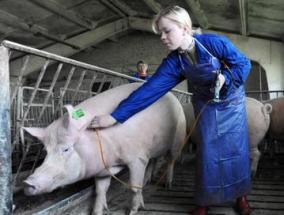Health teams: for future proof pig farms

The pressure is on for reducing antibiotics in animal production systems. But to be successful in this, the veterinarian, farmer and nutritionist should cooperate more in the form of ‘health teams’.
By Emmy Koeleman
Having recognised©that bacteria are getting more resistant, countries are working hard to reconsider the way antibiotics are used in livestock. These efforts already started many years ago. Sweden©stopped the administration of antibiotics used for growth promotion (i.e., non-medical uses) in 1986.
Denmark enforced this ban for finishers in 1998 and for weaners in 1999. Today in Denmark, all uses of antibiotics in food animals must be accompanied by a prescription in a valid veterinarian-client-patient relationship, and veterinarians cannot profit from the sale of antibiotics.
In the rest of the European Union, the use of all non-medicinal antibiotics in animal feed has been banned since January 2006 and also in many countries the discussion is on to forbid©veterinarians from having their own pharmacy and profiting from prescribing©antibiotics. The efforts made so far by the industry show that the livestock industry has taken responsibility for©its part. Now its time to make the next step in reducing the antibiotic load, by controlling the medicinal use through management, nutrition and most of all by sharing expertise.
Health teams
But we have to make clear that antibiotics cannot be phased out completely. The pig industry simply cannot go without any antibiotics, just like in humans. Diseases with high prevalence in the pig industry such as respiratory tract infections, gastro-intestinal disorders, meningitis and arthritis are a threat, and we should have the freedom to use the antibiotics for these illnesses when needed.
We do want veterinarians to have the freedom to cure animals, right? Fluruoquinolones and cephalosporins©for example should therefore still be alternatives for treatment of diseases in food producing animals but should be used with care.©Nevertheless, policy makers©often call for a 50% reduction, which puts a lot of pressure on farmers.
Keeping animals under these ‘new conditions’ requires more knowledge, of which the veterinarians have the animal health part and the feed consultants the nutrition part. Therefore, it is so important to work together as ‘health teams’, to benefit from each other’s expertise. Denmark, Portugal, Canada and the US are some of the leading countries encouraging the building of strong cooperations between farmers and veterinarians, in an attempt to step up the health status. In many other countries there is hardly any cooperation.
Investing for the future
Of course, the farmer has a major responsibility to keep the antibiotic use under control.©Good quality feed, climate, housing, no stress, good observation of the animals etc, can make the difference. Also not pushing the animals to achieve unnaturally high production levels can reduce the prevalence of certain diseases on the farm.
The formulation of the feed is also very important. Countries use different rules regarding Zinc for example, and the discussion to re-introduce meat and bone meal in animal diets is important in the whole animal health issue. Some farmers might also be calling for less cleaning, to step up the natural immune system of the pigs.
But what can farmers do on a practical level? Pig farmers may not be so willing to invest in a quarantine unit for the import of gilts or to create a separate alley for piglets and sows.
However more practical recommendations©could include improved hygiene in the piglet units, a more strict euthanasia policy, closure of holes and cracks in the stall and a separate hygiene sluice for weaned piglets. But to convince farmers to work on the issue can sometimes be difficult, as he or she need to be convinced that the measures on the farm really contribute to an increased health status of the farm.©Working on the health status in the form of a ‘health team’, I believe, is the way forward. It would not only be an easier transition but©more efficient, as more information and knowledge is shared before the decision is made.











